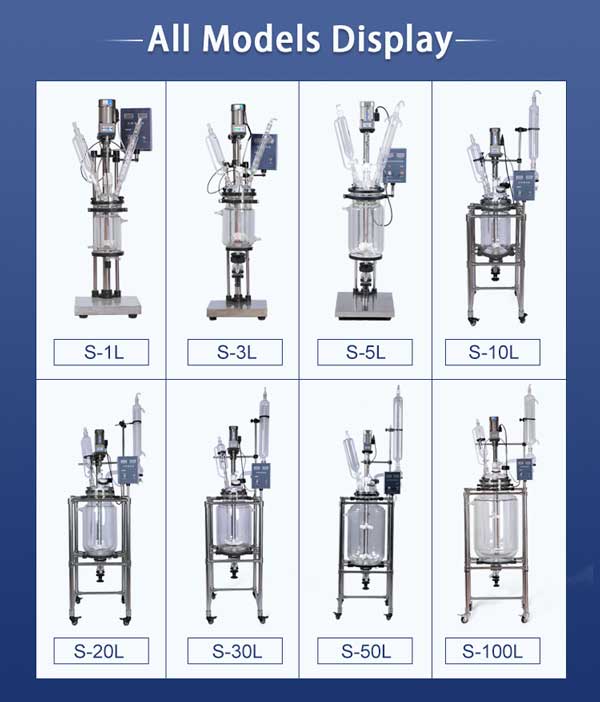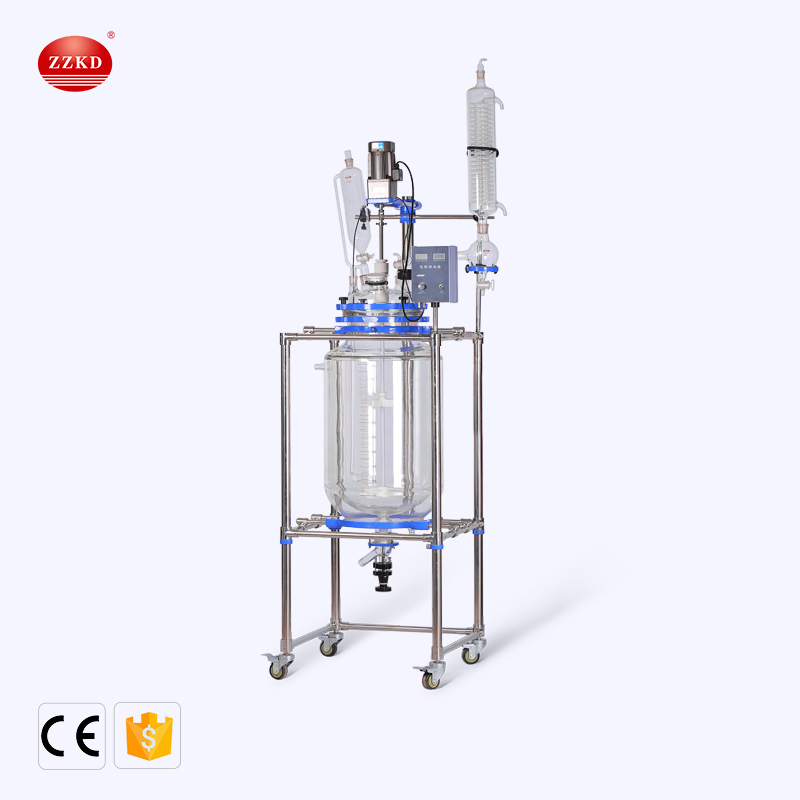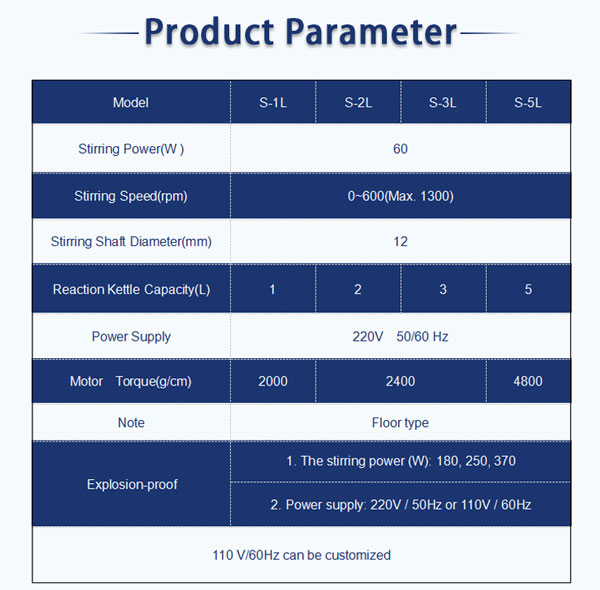Glass Jacketed Flask Reactor Vessel For The Pharmaceutical Industry
The equipment involved in pharmaceutical engineering is very large, and the double layer glass chemical reactor agitated with stirring device .It is often used in the field of pharmaceutical engineering. The material is mixed by stirring, which greatly accelerates the mass transfer and reaction, and at the same time plays the role of strengthening heat transfer. The quality of the stirring effect directly affects the stability of subsequent processes and drug production. the quality of. Based on the principle of the utility model, ZZKD discloses a stirring device for biopharmaceuticals—glass jacketed flask reactor vessel. In addition, ZZKD provides a series of distillation and extraction devices: mini rotary evaporator, cdu 1000 distillation and other equipment.

What is a glass jacketed flask reactor vessel?
The glass phase reactor mainly uses its double-layer glass characteristics. We can place the reaction material in the middle interlayer, and by stirring the reaction under normal pressure or negative pressure, the glass jacketed flask reactor vessel passes through the double-layer reactor interlayer and injects The constant temperature hot solution or cooling liquid can heat or refrigerate the materials in the reactor at a constant temperature, and can provide stirring. In this way, the medium in the glass jacketed flask reactor vessel interlayer is heated or cooled by stirring to perform a cyclic reaction. It is a commonly used biochemical instrument and is widely used in modern fine chemicals, biopharmaceuticals, scientific research and experiments and other industries. It can be used for concentration, distillation, reflux, separation and purification reactions under the conditions of constant speed, constant force and constant temperature. It is a teaching, Ideal equipment for experiment, pilot test and production.
Common glass jacketed flask reactor vessels on the market can be divided into two categories, namely single-layer glass flask reactor vessel and glass jacketed flask reactor vessel.
Single layer glass jacketed flask reactor vessel
The single-layer glass flask reactor vessel is stirred and reacted under normal pressure or negative pressure in a closed container under a set constant temperature, and the evaporation and reflux of the reaction solution can be controlled. Generally, there are single-layer glass flask reactor vessel, double-layer glass flask reactor vessel and three-layer glass flask reactor vessel.
glass jacketed flask reactor vessel
The glass jacketed flask reactor vessel can be used for high temperature reaction (the highest temperature can reach 300℃); it can also be used for low temperature reaction (the lowest temperature can reach -80℃); the glass jacketed flask reactor vessel can be evacuated to do vacuum decompression reaction. Its unique design makes the test temperature control more precise and ensures that the experiment is carried out in a safer environment.

Glass jacketed flask reactor vessel technical features:
1. Because the material used in glass jacketed flask reactor vessel (GG17 high borosilicate glass) has excellent material and chemical properties. During the stirring process of variable frequency speed regulation, the operation will be relatively stable, and no spark will be generated even if the torque is large.
2. In addition, the components are sealed with tetrafluoroethylene, which can maintain a good vacuum degree (generally around -0.095mpa) among similar products in the market, and maintain high-precision sealing under working conditions. There is also a chip collection groove.
3. Alloy steel mechanical seal, PTFE connection port, maintain high-precision seal under working condition.
4, Pt100 sensor probe, high temperature measurement accuracy, small error, effectively improve work efficiency
5. The PTFE discharge valve can move the interface, and the discharge is thorough and fast.
6. The cooling or heating solution of the glass jacketed flask reactor vessel interlayer can be completely drained after the reaction is completed, and no liquid will accumulate.
7. Strong torque, no noise. Adopted Japanese technology AC gear motor
8. Double PTFE stirring paddle for glass jacketed flask reactor vessel, suitable for stirring and mixing liquids with low to high viscosity.

Precautions for the use of glass jacketed flask reactor vessel:
The glass jacketed flask reactor vessel is widely used in the pharmaceutical industry, but if the glass jacketed flask reactor vessel is used incorrectly, it will not only directly damage the glass jacketed flask reactor vessel equipment, but also indirectly increase the production cost. According to the industry, some parts of the glass jacketed flask reactor vessel are easy to be overlooked by the operators during the working process, and they need to be paid great attention. Specifically, there are mainly the following aspects.
First, the choice of medium
Due to the small thickness of the interlayer in the middle of the glass jacketed flask reactor vessel, the thermal insulation performance is poor. Therefore, in the process of using high temperature and low temperature, it is necessary to use thermal insulation materials for thermal insulation protection of the kettle body. The kettle body and the liquid-conducting pipes of the reaction kettle need to be wrapped with thermal insulation materials, and attention should be paid to the thickness of the thermal insulation layer to ensure a good thermal insulation effect.
In terms of temperature control medium selection, users can select temperature control medium with different properties according to the required reaction temperature as the heat transmission medium for the reaction. When using low temperature or high temperature, pay attention to select the appropriate medium.
"The key lies in the viscosity. The medium circulation pump with too much viscosity may not be able to carry it, and the circulation effect is not good, and the satisfactory temperature control effect cannot be achieved. And rashly replace the high-power circulation pump, which is easy to damage the double-layer glass jacketed flask reactor vessel. The lining will cause the reactor to rupture." According to the industry, under normal circumstances, manufacturers will match the corresponding heating medium for users to choose according to their own products.
Second, the storage location
The glass jacketed flask reactor vessel is used as a reaction scale-up test device. The volume is usually 50-150L, and the volume can be customized in specific cases. Therefore, the scale of the test should not be underestimated. Since the kettle body is made of glass, stainless steel is the bracket and the legs are casters, the storage location needs to be carefully selected.
According to some users' reactions, although the casters of the glass jacketed flask reactor vessel can be fixed with foot buckles, the stability is not strong. Therefore, pay attention to choose a flat place during storage, lay it as flat as possible, and keep the mechanical stirring center consistent with the reaction kettle, otherwise it will be easy to shake and become unstable and cause safety accidents. In addition, the general floor fume hood cannot be placed, but it must be placed in a well-ventilated place.
Third, the feeding process
The glass jacketed flask reactor vessel is an independent reaction rack, and the reserved feeding port is small, so the feeding process is difficult.
It is recommended in the industry that for solid reagents, it is recommended to prepare a solution and add it to the kettle, while liquid reagents can be pumped into the kettle through a matching water pump or oil pump.
It is worth noting that when the reaction material is added to the reaction kettle through a constant pressure dropping funnel or a common dropping funnel, a corresponding mobile ladder needs to be matched so that the staff can add the test material.
In addition, during the feeding process, the one-time feeding amount of the glass jacketed flask reactor vessel should not be too large, and the appropriate feeding amount can be added after evaluation according to the reaction temperature, reflux and pressure.
In addition to the above precautions, users also need to regularly maintain the glass jacketed flask reactor vessel in the usual use process to ensure the life of the equipment and reduce the cost of the enterprise.